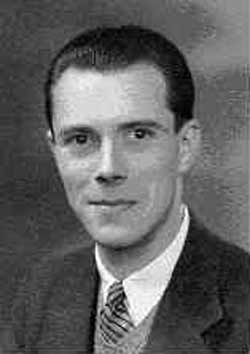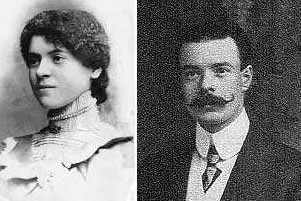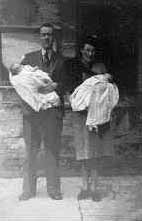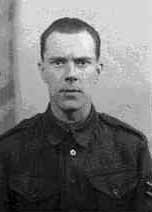HOME GUARD MEMORIES AND INFORMATION - WARWICKSHIRE, BIRMINGHAM
LESLIE RICHARD DANIEL McGREGOR
a.k.a.
Lt. L.R.D. McGregor,
37th Warwickshire (Birmingham) Battalion,
Sparkbrook/Small Heath
This is a page within the www.staffshomeguard.co.uk website. To see full contents, go to SITE MAP.
|
A Biography
of
LESLIE McGREGOR
(1913-1985)
by Martin McGregor
 Leslie Richard Daniel McGregor was born on 21 October 1913 at 49 Sampson Road, Sparkbrook, Birmingham. He was the only son of Daniel McGregor, inventor and businessman, and Beatrice Florence Whitney, furrier. Leslie had an elder sister, Gladys, and two younger sisters, Muriel and Jean.
Leslie Richard Daniel McGregor was born on 21 October 1913 at 49 Sampson Road, Sparkbrook, Birmingham. He was the only son of Daniel McGregor, inventor and businessman, and Beatrice Florence Whitney, furrier. Leslie had an elder sister, Gladys, and two younger sisters, Muriel and Jean.
The father, Daniel McGregor had been born in Manchester but moved to Birmingham with his parents when he was very young. Beatrice McGregor (nee Whitney), Leslie's mother, was born in Elmley Castle, Worcestershire.

 Leslie was educated at Conway Road School (right). His School Leaving Certificate noted that he acted as a perfect gentleman, a reputation he lived up to all his life. On leaving school, he was employed by his father who owned a business manufacturing field telephones for the British Armed Forces and other telephonic equipment. This business was liquidated as a result the Great Depression because its debtors could not be reeled in but it is understood that the government eventually purchased the business. This happened in the later stages of the depression, in the late 1930s.
Leslie was educated at Conway Road School (right). His School Leaving Certificate noted that he acted as a perfect gentleman, a reputation he lived up to all his life. On leaving school, he was employed by his father who owned a business manufacturing field telephones for the British Armed Forces and other telephonic equipment. This business was liquidated as a result the Great Depression because its debtors could not be reeled in but it is understood that the government eventually purchased the business. This happened in the later stages of the depression, in the late 1930s.

 Leslie married Marjorie May Hawkins on 4 November 1939 at Christ Church Anglican Church, Sparkbrook. Marjorie was born at 129 Osborne Road, Sparkbrook, the daughter of Bertram Arthur Hawkins, silversmith with Joseph Gloster Ltd, and Nellie Brampton. Marjorie worked in her first job as an accounts clerk/book-keeper at Greeners gunsmiths. She worked between 1928 and 1937 for The Pennant Manufacturing Co.Ltd. and between 1949 and 1961 for Stephens Belting. The couple initially moved in to Leslie’s parent’s house in Sampson Road.
Leslie married Marjorie May Hawkins on 4 November 1939 at Christ Church Anglican Church, Sparkbrook. Marjorie was born at 129 Osborne Road, Sparkbrook, the daughter of Bertram Arthur Hawkins, silversmith with Joseph Gloster Ltd, and Nellie Brampton. Marjorie worked in her first job as an accounts clerk/book-keeper at Greeners gunsmiths. She worked between 1928 and 1937 for The Pennant Manufacturing Co.Ltd. and between 1949 and 1961 for Stephens Belting. The couple initially moved in to Leslie’s parent’s house in Sampson Road.
During his early years of employment, Leslie picked up many skills associated with engineering. He became a skilled engineering draughtsman and developed skills in machine tool design, time and motion study and plant layout sufficient to eventually obtain employment in factory management. It is not clear as to where he was employed in the late thirties and early forties but at the time of the birth of his twin sons in September 1942 he was a rate-fixer at a munitions works. However, by 1943 he was employed by Charles Pugh Ltd, manufacturers of the Atco range of motor mowers, and he was still employed there when the war ended.
In early 1942, Daniel McGregor, already alarmed by bombing going on all around his home in Sparkbrook, decided to evacuate the family from Birmingham. It appears that he owned a lorry, or at least managed to obtain one somehow, and he piled the whole family and their possessions into it and drove out of Birmingham in the middle of the night whilst an air raid was in progress. When dawn broke, they found themselves in Henley-in-Arden and Daniel, taking an immediate liking to the place, decided to settle the family there. He bought a large house in the High Street. The occupants of the lorry were Daniel and Beatrice, his unmarried daughters Muriel and Jean, Leslie and Marjorie. Although the house was large, there was not quite enough room for all and so, whilst Daniel and Beatrice and the two daughters moved into 48 High Street, Leslie and Marjorie boarded at 5 Cherry Orchard.
 Twin sons were born to Leslie and Marjorie on 2 September 1942. The boys were born at Warneford Hospital in Royal Leamington Spa because Marjorie was unable to be accommodated at Stratford-upon-Avon hospital. The boys were baptized at St. John’s Anglican Church at Henley-in-Arden. Unfortunately, David was diagnosed with a hole in the heart and died in 1943, just a few weeks short of a scheduled operation that might have saved his life. Later in 1942, Leslie and Marjorie bought a house in Colebrook Road in Shirley or, more specifically, Haslucks Green. Life at 5 Cherry Orchard had become difficult with the arrival of the twins and because the owners of the house had family members of their own needing accommodation. There was also the need for Leslie to be closer to his work and his involvement with the Home Guard. The Colebrook Road house was ideal, being near to the railway station and a choice of bus services. Marjorie’s parents left their home in Osborne Road and went to live with Leslie and Marjorie in Colebrook Road.
Twin sons were born to Leslie and Marjorie on 2 September 1942. The boys were born at Warneford Hospital in Royal Leamington Spa because Marjorie was unable to be accommodated at Stratford-upon-Avon hospital. The boys were baptized at St. John’s Anglican Church at Henley-in-Arden. Unfortunately, David was diagnosed with a hole in the heart and died in 1943, just a few weeks short of a scheduled operation that might have saved his life. Later in 1942, Leslie and Marjorie bought a house in Colebrook Road in Shirley or, more specifically, Haslucks Green. Life at 5 Cherry Orchard had become difficult with the arrival of the twins and because the owners of the house had family members of their own needing accommodation. There was also the need for Leslie to be closer to his work and his involvement with the Home Guard. The Colebrook Road house was ideal, being near to the railway station and a choice of bus services. Marjorie’s parents left their home in Osborne Road and went to live with Leslie and Marjorie in Colebrook Road.
The Home Guard Years
 It is not clear when Leslie joined the Home Guard but it was definitely prior to the family moving to Henley-in-Arden. Leslie was rejected for active service because he was stone deaf in his right ear from having a mastoid bone smashed in an accident during his youth. He appears to have made his way up through the ranks, having been a corporal prior to his promotion to lieutenant. Likewise, not much is know about his activity in the Home Guard except that he was generally deployed in the Sparkbrook, Small Heath area of Birmingham, primarily involved with anti-air raid defence. However, he was not confined to that. He was a training officer who specialized in training in anti-aircraft gun crews, but also unarmed combat and guerrilla tactics. Later in the war he obtained his certificate to train troops in the use of artillery rockets and missiles. In his training role he travelled around the country a bit and for some time was based in Plymouth where he trained anti-aircraft gun crews. He seems to have spent a considerable amount of time based in Plymouth because he had permanent digs there. One house where he was billeted was totally destroyed by a bomb whilst he was working in the naval base. After that, he billeted with a widow whose daughter was in the WRENS. It is not clear when Leslie joined the Home Guard but it was definitely prior to the family moving to Henley-in-Arden. Leslie was rejected for active service because he was stone deaf in his right ear from having a mastoid bone smashed in an accident during his youth. He appears to have made his way up through the ranks, having been a corporal prior to his promotion to lieutenant. Likewise, not much is know about his activity in the Home Guard except that he was generally deployed in the Sparkbrook, Small Heath area of Birmingham, primarily involved with anti-air raid defence. However, he was not confined to that. He was a training officer who specialized in training in anti-aircraft gun crews, but also unarmed combat and guerrilla tactics. Later in the war he obtained his certificate to train troops in the use of artillery rockets and missiles. In his training role he travelled around the country a bit and for some time was based in Plymouth where he trained anti-aircraft gun crews. He seems to have spent a considerable amount of time based in Plymouth because he had permanent digs there. One house where he was billeted was totally destroyed by a bomb whilst he was working in the naval base. After that, he billeted with a widow whose daughter was in the WRENS.
 The photograph above shows Leslie in his garden some time after he had been promoted to lieutenant. Another earlier image (left) also survives and was taken at the time when he was still a corporal. The photograph above shows Leslie in his garden some time after he had been promoted to lieutenant. Another earlier image (left) also survives and was taken at the time when he was still a corporal.
A third image depicts officers and NCOs of the unidentified unit to which Leslie belonged, part of the 37th Warwickshire Battalion. Leslie is seated on the extreme right.

Leslie did not talk much about his involvement with the Home Guard but he clearly gave the impression he enjoyed it. He talked about a group of British Army officers who went around the Home Guard units talking about guerilla warfare tactics. He said that some of these officers had volunteered to fight in the international brigades during the Spanish Civil War in order to study the tactics. He also said that former Spanish officers and soldiers had been involved in training British troops. He also gave the impression he had a very high regard for the officers and men in his unit in Birmingham. He did not seem to have formed a friendship with any particular fellow soldier and he did not keep up any friendships he might have formed after the war. Only one name comes to mind as one he mentioned as a friend, that being Mike Slin – though this name might be wrong.
Several attributes may have contributed to his promotion to commissioned rank. Firstly, he had managerial skills and was particularly good at problem-solving. He also had good leadership skills, he was good with people. Thirdly, he was a skilled and formidable fighter. He had a passion for soccer, but also for boxing and wrestling at which he was very good. He had also been very active in the Scouting movement in his youth.
Three anecdotes about his war years have survived and all of them have something to do with his Plymouth postings.
Whilst based in Plymouth he indulged in his hobby of coin collecting, playing swaps with returning sailors. Unfortunately, he kept the bulk of this collection in the house he was billeting and it was all lost when the house was bombed. However, he left several hundred coins with his wife Marjorie and this collection survived the war and is now in the possession of his son.
The second anecdote concerns a tremendous fight he got into in a Plymouth pub when he apparently took on a couple of dozen sailors single-handed and won. Nothing is known about the circumstances of this scrap because he was a tea-totaller all his life, he didn’t womanize, gamble, or do any of the things that might cause him to be in a pub. In fact, he never went into pubs except, it seems, on this one occasion.
The third anecdote concerns a time when he was on leave from Plymouth and back “home” in Henley-in-Arden and concerns a riot which took place in a ‘lunatic asylum’ called Glendossil, just to the south of Henley. Leslie turned out to be the senior Home Guard officer in town and it fell to him to lead a squad into Glendossil to put down the riot, which he did in short order.
Leslie seemed to know a lot about the war operations in general and had opinions about the commanding officers. He had a great respect for Wavell and Alexander but was somewhat critical of Montgomery because of that general’s somewhat boastful style. He was sceptical about the merits of the American commanders. He mentioned the Chindits with admiration.
At the end of the war, the victory celebrations, consisting mainly of a party for the children, was held in Colebrook Croft, a convenient cul-de-sac in Haslucks Green. Leslie carried on his army associations and was attached to a Territorial Army unit based at Shirley Barracks in Haslucks Green Road. I have been unable to find out which unit this was. Shirley Barracks was used by the ATC and the Sea Scouts but there was a Territorial Army unit base there. I think it was either the Royal Engineers or Royal Artillery. Royal Artillery seems more likely because the commanding officer eventually asked Leslie to retire because the Army did not want responsibility for any damage to his hearing, Leslie being stone deaf in one ear. Presumably, the unit was involved in occasional exercises involving high sound levels.
 A few relics of Leslie McGregor's wartime activities survive: officer’s Sam Brown,
officer’s baton (swagger stick), Royal Warwickshire Regiment cap badge, officer's pips (metal and fabric), gas mask, a rocketry instruction certificate and two instruction books on unarmed combat - all of them traces from a desperate and long-disappeared era. A few relics of Leslie McGregor's wartime activities survive: officer’s Sam Brown,
officer’s baton (swagger stick), Royal Warwickshire Regiment cap badge, officer's pips (metal and fabric), gas mask, a rocketry instruction certificate and two instruction books on unarmed combat - all of them traces from a desperate and long-disappeared era.
|
After the war Leslie was employed by a number of firms in a management role. Amongst them was George Snape & Co (coppersmiths), BSA, Velocette, GEC, GKN and a couple of others. He was works manager for T.F.Blumfield until 1960 but there is no record of his length of employment with that firm. At the BSA he was involved in time and motion study, plant layout engineering and machine tool design and was a member of the middle-management team. From 1966 to 1971, he worked for Messengers Ltd in the work study department. He was also stage manager for the BSA amateur dramatics society. He had a particularly high regard for Sir Bernard Docker and Mike Sangster and when Sangster moved to London to take up a political career, he asked Leslie to be his personal right hand man, but Leslie declined for reasons he never disclosed. He probably didn’t like the idea of living in London. He and Marjorie moved to New Zealand in 1971 to be with his son and daughter-in-law and they settled in the picturesque Auckland suburb of Tititangi. Leslie got a job with the engineering importing firm of Kidd Garrett and then later with Rishworth and Mahaffey until he retired at the age of 65. He died at his home in Titirangi on 6 September 1985.
Leslie was 6ft 2in tall and weighed around 12½ stone for most of his adult life. He wore a size 12 shoe and he had long arms and large hands. He had black hair which he always wore short back and sides, combed straight back without a parting and Brylcreemed. His hair receded at the temples but he never went bald on the crown. He had grey eyes although this does not show up in photos. He had family features such as a high forehead, deep upper lip and a straight, fine-ridged nose. He never showed his teeth when he smiled, a family trait to this day.
In his youth he played soccer and was active in boxing and wrestling. He never lost his passion for soccer and boxing. He was a keen supporter of Birmingham City F.C. He was also a keen tennis player and he did a lot of cycling. He mentioned the Sparkhill Harriers as if he had been a member. He and Marjorie possessed a tandem for many years. He liked dancing and had a fine collection of traditional jazz and Dixieland music. He had a very good baritone singing voice but there is no evidence that he ever belonged to a choir. He did not play a musical instrument of any kind. As a boy he was active in the Boy Scouts and belonged to the Sparkbrook troop. After the war, he and Marjorie regularly went ballroom dancing and he joined the Caledonian Corks social club. Whilst working at the BSA he became involved with the works amateur dramatics society and stage managed several productions, playing the occasional walk-on role. The couple never missed having Summer holidays away, usually a fortnight at a different spot each year, but Swanage was a favourite. They also made weekend trips to the Elan Valley, Blackpool and London.
Leslie was a very proficient home handyman who could turn his hand to almost everything. He developed a very attractive rock garden at his home in Shirley, using dry-stone walling of Cotswold stone and crazy paving. He was also very good at painting and decorating. He had a huge collection of tools, some of which he had inherited from other family members and many of these tools are now in the possession of his son. Unfortunately, he had to leave many of his tools behind when he moved to New Zealand and this nearly broke his heart.
As an individual, Leslie was greatly respected by all who made his acquaintance for the gentlemanly manner in which he conducted himself. His manners were always impeccable, polite, genial and courteous. He was always courteous to women and treated them as equals. He was always calm and collected; even though he was capable of a furious temper if provoked, and he never lost control. He was rarely ill but, even when he was, he suffered in silence and never complained. He seemed to regard illness or injury as an annoyance. He never swore. He never gambled although he enjoyed an occasional game of cards playing for pennies. He was a tea-totaller, although he kept a good liquor cabinet for the benefit of occasional guests and he would allow himself one scotch at Christmas time. He was mildly disdainful of people who drank scotch with water. At work, he was respected for his honesty, ability, reliability, work ethic and amiable personality.
Leslie was not a gregarious person but he did value one or two close friends. He and Marjorie rarely entertained, however. But, Leslie was very close to his parents, sisters and other members of his own family and was also very friendly towards Marjorie’s family. As a father, he gave his surviving son every support possible and passed on much of his practical knowledge to him. He doted over his grand-children. Surprisingly, Leslie knew little of the history of his own family, this being the province of two of his aunts.
The three things Leslie would not talk about was religion, politics and money because he believed that wars, divided families and broken friendships were caused by disputes and differences of opinions over those three subjects. He was a Christian and had a high regard for Jesus as a person who led by example, but he never attended church except for weddings, baptisms and funerals. He had a great respect and tolerance for all religious beliefs. He was also respectful and tolerant towards people of other nationalities and races and was on friendly terms with many in the Indian, Jewish and Irish communities in the Birmingham area. He never revealed his politics or how he voted but, judging by the fact that he clearly did not like Clement Atlee or Harold Wilson, he most likely would have voted Conservative. Mind you, he was also critical of Neville Chamberlain, Anthony Eden and even Winston Churchill as a peace time prime minister.
Above all, Leslie lived up to his own high standards of personal behavior and the belief that good men should lead by example. He never let himself or anyone else down.
Acknowledgements:
We make grateful acknowledgement to Martin McGregor who wrote the above biography of his father for his generous permission for its publication within this website.
Images and text © Martin McGregor 2010